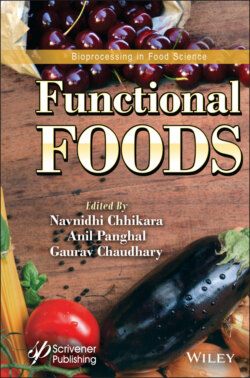Читать книгу Functional Foods - Группа авторов - Страница 2
Table of Contents
Оглавление1 Cover
2 Title Page
3 Copyright
4 Preface
5 1 Overview of Functional Foods 1.1 Introduction 1.2 Functional Food History and Market 1.3 Classification of Functional Foods 1.4 Types of Functional Foods 1.5 Functional Foods and Health Claims 1.6 Conclusion References
6 2 Prebiotics and Synbiotics in Functional Foods 2.1 Introduction 2.2 Prebiotics 2.3 Prebiotic Dairy Functional Foods 2.4 Synbiotics 2.5 Synbiotic Dairy Functional Foods 2.6 Conclusions Acknowledgements References
7 3 Cereal-Based Functional Foods 3.1 Introduction 3.2 Structure and Chemical Composition of Cereal Grains 3.3 Functional Foods Produced from Cereal Grains 3.4 Conclusion References
8 4 Millet Based Functional Food 4.1 Introduction 4.2 Classification of Millets 4.3 Nutritional Importance of Major and Minor Millets 4.4 Grain Structure and Chemical Composition 4.5 Functional Compounds Present in Millets 4.6 Millet and Sorghum Based Commercial Products 4.7 Millet Based Functional Food Products 4.8 Health Benefits of Millet Based Functional Food 4.9 Future Aspects 4.10 Challenges 4.11 Conclusions References
9 5 Dairy Milk Based Functional Foods 5.1 Introduction 5.2 Functional Foods and Regulation 5.3 Functional Dairy Foods 5.4 Industrial Processing of Functional Dairy Products 5.5 Conclusions Acknowledgements References
10 6 Fruits and Vegetable Functional Foods 6.1 Introduction 6.2 Fruit and Vegetable as Functional Ingredients 6.3 Common Functional Compounds in Fruits and Vegetables 6.4 Physicochemical Treatments to Produce Fruit and Vegetable Based Ingredients 6.5 Main Technologies to Obtain Powder Ingredients from Fruits and Vegetable 6.6 Foods as Carriers of Bioactive Compounds from Fruits and Vegetable 6.7 Fruits and Vegetable By-Products as Functional Ingredients 6.8 Impact of Food Processing on the Biofunctional Properties 6.9 Concluding Remarks and Future Outlooks Acknowledgements References
11 7 Meat Based Functional Foods 7.1 Introduction 7.2 Meat Role in the Nourishments 7.3 Types of Meat 7.4 Benefits of Consuming Meat 7.5 Concept of Functional Foods 7.6 Creation of Functional Foods Based on Meat 7.7 Innovation of Technology for New Dietary Principles 7.8 Conclusion References
12 8 Seafood Based Functional Foods 8.1 Introduction 8.2 Fish Protein Hydrolysates 8.3 Fish Oil 8.4 Chitin 8.5 Fish Roe 8.6 Gelatine 8.7 Conclusions References
13 9 Millet Based Functional Foods: Bio-Chemical and Bio-Functional Properties 9.1 Introduction 9.2 Recent Developments on Millet Based Functional Foods 9.3 Millet Nutrition Profile 9.4 Bioactivities of the Millet Based Functional Foods Compounds 9.5 Biomedicinal and Health Potential of Millet-Based Foods 9.6 Conclusion References
14 10 Mushroom as a Source of Fungal Based Functional Foods 10.1 Introduction 10.2 Life Cycle of Mushroom 10.3 Different Types of Mushroom Cultivation Process 10.4 Traditional and Valorised Substrates Used for Cultivation of Mushroom Under SSF Process 10.5 Challenges of Mushroom Cultivation and Upcoming Strategies 10.6 Mycelium Physiology 10.7 Mushroom Mycelium Cultivation Status 10.8 Enhancement of Nutritional and Therapeutic Attributes Present in Mycelium and Mushroom 10.9 Nutraceuticals Compounds Present in Mycelium and Mushroom Along with their Therapeutic Effects 10.10 Food Products Developed from Mushroom Mycelium and Fruit-Bodies 10.11 Umami Flavour Extracted from Mushroom Mycelium and Fruit-Bodies 10.12 Conclusion References
15 11 Probiotics and Prebiotics as Functional Foods 11.1 Introduction 11.2 Immunity of the Gut and its Connection to Microbes 11.3 An Overview of Functional Foods 11.4 Critical Evaluations on Probiotics and Prebiotics 11.5 Conclusions References
16 12 Food Function and Health Benefits of Functional Foods 12.1 Introduction 12.2 Functional Foods Terminology and Definition 12.3 Constituents in Functional Foods 12.4 Bioactive Compounds in Functional Foods 12.5 Health Benefits 12.6 Sources of Functional Foods 12.7 Effect of Processing on Functional Products 12.8 Present Status and Future Aspects 12.9 Conclusion References
17 13 Double Emulsion for Controlled Delivery of Functional Food Ingredients 13.1 Introduction 13.2 Double Emulsion Formation Mechanism 13.3 Types of Functional Ingredient for Delivery 13.4 Double Emulsion Particle Specification 13.5 Double Emulsion Stability 13.6 Release Characteristics 13.7 Gastrointestinal Properties 13.8 Conclusion References
18 14 Use of Biopolymers for Packaging of Functional Foods 14.1 Introduction 14.2 Applications of Biopolymers in Scientific Fields 14.3 Food Product Processing 14.4 Use of Biopolymers for Packaging of Functional Foods 14.5 Biopolymers Used for Processing of Functional Foods 14.6 Conclusion References
19 15 Global Concepts and Regulations in Functional Foods 15.1 Introduction 15.2 Regulatory Framework of Functional Foods 15.3 Conclusions Acknowledgements References
20 Index
21 End User License Agreement
